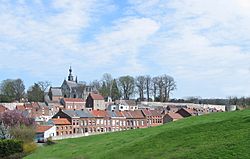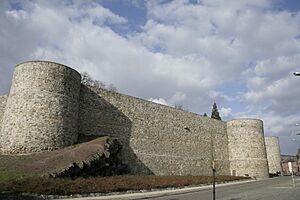Binche facts for kids
Quick facts for kids
Binche
Bince (Walloon)
|
|||
|---|---|---|---|

Binche, the old city and its surrounding wall
|
|||
|
|||
| Country | Belgium | ||
| Community | French Community | ||
| Region | Wallonia | ||
| Province | Hainaut | ||
| Arrondissement | La Louvière | ||
| Population
(2018-01-01)Lua error in Module:Wd at line 1575: attempt to index field 'wikibase' (a nil value).
|
|||
| • Total | Lua error in Module:Wd at line 1,575: attempt to index field 'wikibase' (a nil value). | ||
| Postal codes |
7130, 7131, 7133, 7134
|
||
| Area codes | 064 | ||
| Website | www.binche.be | ||
Binche is a lively city and municipality in Wallonia, Belgium. It is located in the province of Hainaut. Since 1977, Binche has included several smaller areas like Bray and Péronnes-lez-Binche.
Binche is home to over 33,000 people. Its motto is "Plus Oultre", which means "Further beyond" in Old French. This was the motto of Holy Roman Emperor Charles V. In 1545, he gave the medieval castle of Binche to his sister, Queen Mary of Hungary. She rebuilt it into a grand Binche Palace, but it was later destroyed in 1554.
Binche is famous for its special traditions. In 2003, the amazing Carnival of Binche was recognized by UNESCO. It was named one of the "Masterpieces of the Oral and Intangible Heritage of Humanity." Also, the city's Belfry and City Hall are part of a UNESCO World Heritage List site. They are important for their history and architecture.
Contents
Discovering Binche's Past
Binche started a long time ago, during the Middle Ages. It grew near an old Roman road that connected important cities. This road helped Binche become a center for trade and communication.
The city was officially founded in the 12th century. This happened thanks to Yolande of Gelders. Her son, Baldwin IV, made the city stronger. He built walls to protect it from France. In the 14th century, these city walls were made even bigger.
Binche became very powerful when Belgium was under Spanish rule. Mary of Hungary, who governed the Netherlands for her brother Emperor Charles V, lived here. She built a magnificent palace to rival other grand buildings. Charles V himself visited Binche in 1549, and Mary organized huge celebrations.
However, this time of wealth ended in 1554. The palace, the city, and the surrounding areas were attacked. Troops from King Henry II of France plundered them. For many years after, the Hainaut region saw many conflicts.
Later, the Industrial Revolution brought new life to Binche. Coal mines, brickyards, and factories appeared. Thousands of people also worked from home, making lace or shoes. New services like post offices and train stations were also introduced.
The Famous Carnival of Binche
The three-day Carnival of Binche is one of Belgium's most famous events. It happens just before Lent, which is a 40-day period before Easter.
The main performers are called Gilles. They wear amazing costumes in Belgium's national colors: red, black, and yellow. During the parade, the Gilles throw oranges to the crowd. This tradition is very old and special. In 2003, UNESCO recognized the Carnival as a "Masterpiece of the Oral and Intangible Heritage of Humanity."
-
The Gilles wearing their tall hats with ostrich feathers on Shrove Tuesday.
Sports and Transport
Binche is also known for sports. Each year, the city hosts a professional cycling race called Binche-Chimay-Binche. It is a single-day event for cyclists.
The Binche railway station is an important transport hub. Its large building has a gothic style and beautiful stained glass windows. It is a protected monument. Outside the station, there is a square with statues. These statues honor important figures from Binche's history, like Charles V.
Famous People from Binche
- Gilles Binchois (around 1400 – 1460), a famous composer.
- Berthe Dubail (1911–1984), a talented painter.
See also
 In Spanish: Binche para niños
In Spanish: Binche para niños







